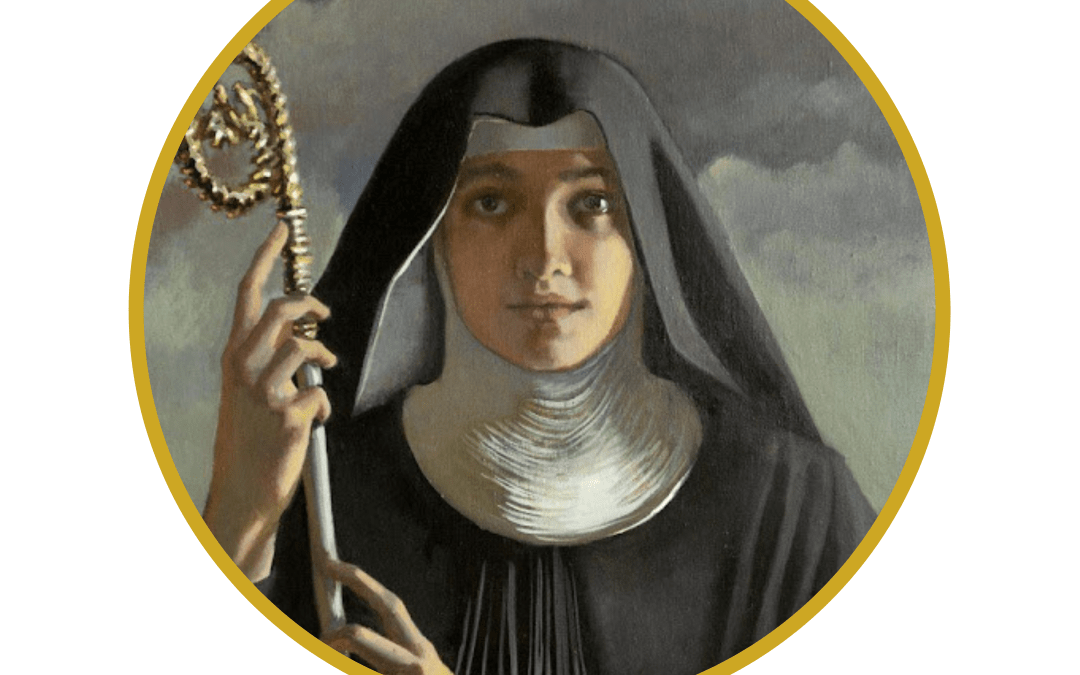
by popadmin | Feb 6, 2022 | CIC Saint Writeups
10 February: Feast of Saint Scholastica. Scholastica was the twin sister of Saint Benedict, the Patriarch of Western monasticism. She was born in Umbria, Italy, about 480. Under Benedict’s direction, Scholastica founded a community of nuns near the great Benedictine monastery Monte Cassino. Inspired by Benedict, from early youth Scholastica dedicated her life to seeking and serving God. In his Second Book of Dialogues, Pope St. Gregory described the last meeting between these holy twins: “His sister Scholastica, who had been consecrated to God in early childhood, used to visit with him once a year. On these occasions he would go to meet her in a house belonging to the monastery a short distance from the entrance. For this particular visit he joined her there and they spent the whole day singing God’s praises and conversing about the spiritual life. When darkness was setting in they took their meal together and continued their conversation until it was quite late. Then the holy nun said to him, ‘Please do not leave me tonight, brother. Let us keep on talking about the joys of heaven till morning.’ ‘What are you saying, sister?’ he replied. ‘You know that I cannot stay away from the monastery.’ The sky was so clear at the time, there was not a cloud in sight. “At her brother’s refusal Scholastica folded her hands on the table and rested her head upon them in earnest prayer. When she looked up again, there was a sudden burst of lightning and thunder accompanied by such a downpour that Benedict and his companions were unable to set foot outside the door. By shedding a flood of tears while she prayed, this holy nun had darkened the cloudless sky with a heavy rain. The storm began as soon as her prayer was over; thunder was already resounding as she raised her head. Realizing that he could not return to the abbey in this terrible storm, Benedict complained bitterly. ‘God forgive you, sister!’ he said. ‘What have you done?’ Scholastica simply answered, ‘When I appealed to you, you would not listen to me. So I turned to my God and He heard my prayer. Leave now if you can. Leave me here and go back to your monastery.’ This, of course, he could not do. He had no choice now but to stay. They spent the entire night together and both of them derived great profit from the holy thoughts exchanged about the interior life. The next morning Scholastica returned to her convent and Benedict to his monastery. Three days later as he stood in his room looking up toward the sky, he beheld his sister’s soul leaving her body and entering the heavenly court in the form of a dove. Overjoyed at her eternal glory, he gave thanks to God in hymns of praise. Then, after informing his brethren of her death, he sent them to bring her body to the abbey and bury it in the tomb he had prepared for himself. The bodies of these two now to share a common resting place, just as in life their souls had always been one in God.” Saint Scholastica died in the year 547. She is the patron saint of convulsive children, nuns, and for protection from rain and storms.
Ideas for celebrating this feast day:
- Tell your children about the “holy twins”: St. Scholastica and the love she had for her brother St. Benedict. Ask them how they can help one another become saints.
- Children can cut paper into the shape of doves to honor St. Scholastica. Decorate the dinner table with these doves. Make an Italian dinner in Scholastica’s honor.
- Look up St. Benedict’s Abbey of Monte Cassino. This videogives a virtual visit.
- Inspired by these holy siblings, learn how to prayerfully read Sacred Scripture in this article Lectio Divina. Click here for more on praying Lectio Divina from the USCCB.
- The need for prayer at this time in history is so great. Inspired by St. Scholastica, come pray the Liturgy of the Hours with your parish family! Sunday at 5pm; Matins/Lauds on M/Th at 7:40 and 8am, Vespers on T/F at 5:30pm.
“She was able to do more because she loved more.”—Saint Gregory the Great. May we all be inspired by St. Scholastica to hold love as the first rule of our lives.
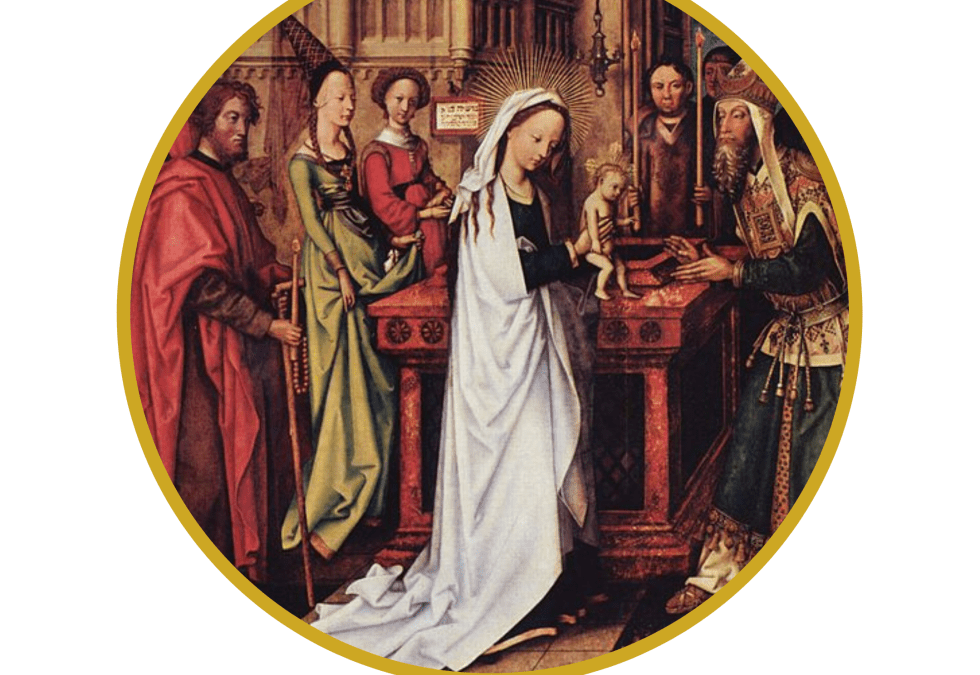
by popadmin | Feb 2, 2022 | CIC Saint Writeups
2 February: Feast of the Presentation of the Lord. Also known as Candlemas, this feast commemorates three distinct but related historical events in the life of the Holy Family. It marks the day when Mary and Joseph brought baby Jesus to the temple in Jerusalem, exactly 40 days after his birth. The Mosaic Law required them to consecrate their firstborn son to God (Exodus 13). Additionally, the law required Mary to submit to ritual purification forty days after childbirth (Leviticus 12:2-8). The ritual involved making a sacrificial offering in the temple. The Gospel of Luke tells us that as Mary and Joseph were poor, they took the option provided for those who could not afford a lamb, sacrificing “a pair of turtledoves, or two young pigeons” (Luke 2:22-24). Neither Mary (perfectly pure and conceived without sin) nor Jesus (God himself) were in need of being purified and consecrated to God; however, they submitted themselves in perfect obedience to God and to the Law of Moses. Our current church calendar focuses this day on the Presentation but in previous eras the Church highlighted the Purification of Mary. {There also used to be a Church custom of “churching” or blessing women forty days after childbirth. It reintroduced the woman to society after her period of recovery at home. Today, churching has disappeared as a custom and now blessing of the mother takes place at the baby’s baptism ceremony.} Today’s feast also commemorates the encounter in the temple between the Holy Family and Saint Simeon the prophet and Saint Anna the prophetess. This is the third and final infancy epiphany of Jesus (the first was to the Hebrew shepherds; the second to the Gentile kings; this third one to the elders of the Israelites). The next epiphany in the life of Jesus will be to the public, at his Baptism in the Jordan. Today’s feast is known by the title Candlemas because of the words of Saint Simeon when he met the child Jesus in the temple: “For my eyes have seen your salvation which you have prepared in the presence of all peoples, a light for revelation to the Gentiles, and for glory to your people Israel” (Luke 2:30-32). Jesus is the Light of the World, the Messiah who has come not just for the Jew but the gentile; not just the righteous, but the sinner. On this feast day, the Church blesses candles for use throughout the year (this has been a church tradition at least since the seventh century). Traditionally, families also bring their own candles to church to be blessed on this feast. The candles represent the fact that the light of the world is here; the light is coming into a dark world as the Church calendar progresses towards the brightness of Easter.
Ideas for celebrating this feast day:
- Go to mass and bring a stack of candles to be blessed for use over the next year! Prince of Peace has mass and blessing of the candles at 8:30am and 7pm on 2 February.
- If you are unable to go to mass, do a family Candlemas procession and prayer at home. Instructions here.
- Candlemas is known in France as “crepe day”. Make savory crepes for dinner (use whole wheat flour and fill them with ham, cheese, etc.) and sweet crepes for dessert (use white flour and top them with fruit, chocolate, whipped cream).
- A Candlemas tradition is to spend the day without electric lights – or at least to eat dinner only by candlelight (using your blessed candles!)
- Say a family rosary by candlelight; the Presentation in the Temple is one of the Joyful Mysteries.
- Meditate on the constant fiatof Our Lady of Sorrows, who embraced the will of God even as Simeon predicted that a sword would pierce her heart.
- If you haven’t taken down your Christmas decorations yet, today’s the day! Candlemas marks the very end of the liturgical season of Christmas.
- Read this articleto learn about the connection between Candlemas and Groundhog Day.
- Read Fr. Butler’s article: The Purification, Commonly called Candlemas-Day and Pope St. JP II’s article: Presentation Prefigures the Cross.
(Sources: catholicculture.org; Catholic All Year Compendium by K. Tierney; Catholicstraightanswers.com)
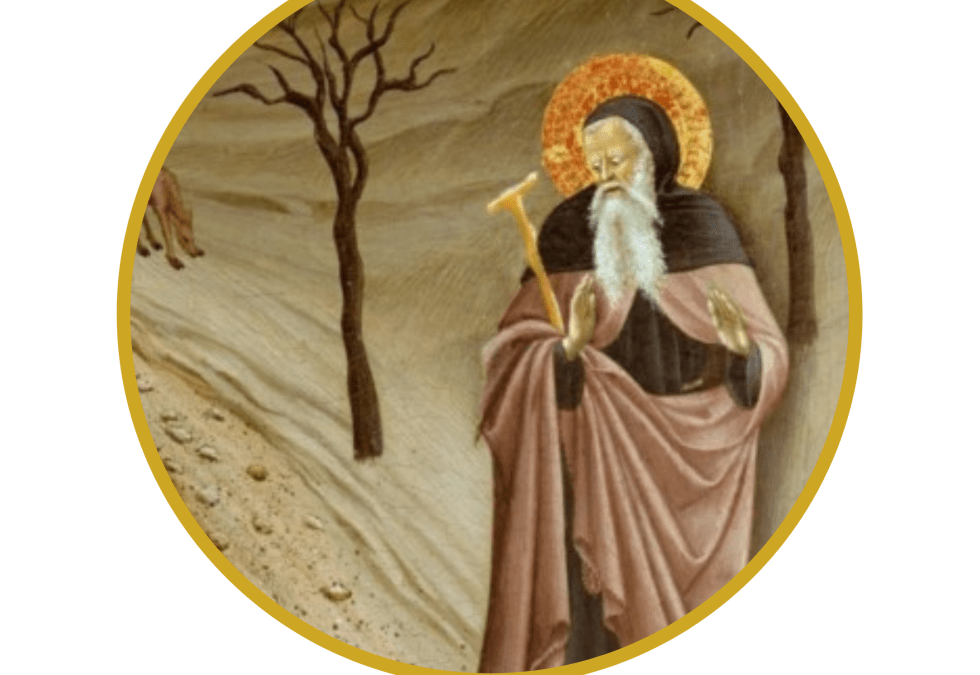
by popadmin | Jan 17, 2022 | CIC Saint Writeups
17 January: Feast of Saint Anthony. Known as Saint Anthony “the Great” and the “Father of Monks”, he was born in Egypt around the year 250 to distinguished parents. After their untimely deaths, he dedicated himself wholly to acts of mortification. One day in church (around age 18) he heard the words of the Gospel: “If you wish to be perfect, go, sell what you have, and give it to the poor” (Matt. 19:21). Anthony felt as if Christ had spoken to him personally, giving a command he must obey. Without delay he sold his property, gave the proceeds to the poor, and went into the desert. He chose an inaccessible place in the wilderness where he dedicated his life to God in manual work and continual prayer. He lived in solitude for over 20 years. His bed was the hard ground. He fasted rigorously, ate only bread and salt, and drank only water. He would not take food before sundown; at times he passed two days without any nourishment. He often spent whole nights in prayer. In his older age, he imparted wisdom to a group of disciples and encouraged them to lead a monastic life. Because he was the first Christian to retire to a monastic life, he is considered to be the first monk and also the father of all monks. Anthony suffered repeatedly from diabolical attacks, but these merely made him more steadfast in virtue. He would encourage his disciples in their struggle with the devil with such words: “Believe me; the devil fears the vigils of pious souls, and their fastings, their voluntary poverty, their loving compassion, their humility, but most of all their ardent love of Christ our Lord. As soon as he sees the sign of the Cross, he flees in terror.” He died in 356 on Mount Kolzin by the Red Sea, at the age of 105. A year later his friend, the fearless bishop and confessor St. Athanasius, wrote his biography, which for centuries became the classic handbook of ascetics. He describes how St. Anthony saw the purpose of asceticism as not to destroy the body but to bring it into subjection, re-establishing man’s original harmonious integrity, his true God-given nature: “His was a perfectly purified soul: no pain could annoy him, no pleasure bind him. In him was neither laughter nor sadness. The sight of the crowd did not trouble him, and the warm greetings of so many men did not move him. In a word, he was thoroughly immune to the vanities of the world, like a man unswervingly governed by reason, established in inner peace and harmony.”
Saint Anthony famously taught his monks: “Let it be your supreme and common purpose not to grow weary in the work you have begun, and in time of trial and affliction not to lose courage and say: Oh, how long already have we been mortifying ourselves! Rather, we should daily begin anew and constantly increase our fervor… And that we may not become weary and disheartened, it is good to meditate on the words of the apostle: ‘I die daily.’ If we live with the picture of death always before our eyes, we will not sin… For our life is by nature uncertain and is daily meted out to us by Providence. If we are convinced of this and live each day as the apostle suggests, then we will not fall into sin; no desire will enslave us, no anger move us, no treasure bind us to earth; we will await death with unfettered hearts.”
Ideas for celebrating this feast at home:
- For dinner, make “St. Anthony of the Desert Soup” – recipe at this link.
- Read Athanasius’ accountof St. Anthony.
- Learn more about Western Monasticism.
- Pray for those in monastic life and pray for a resurgence of vocations to this life.
- As a family, pray to St. Anthony for vigilance in the fight against temptations and sin.
- Make a sacrifice or mortification on behalf of someone in need of Christ’s mercy or healing.
(Sources: exerpts from The Church’s Year of Grace by Pius Parsch; catholicculture.org)
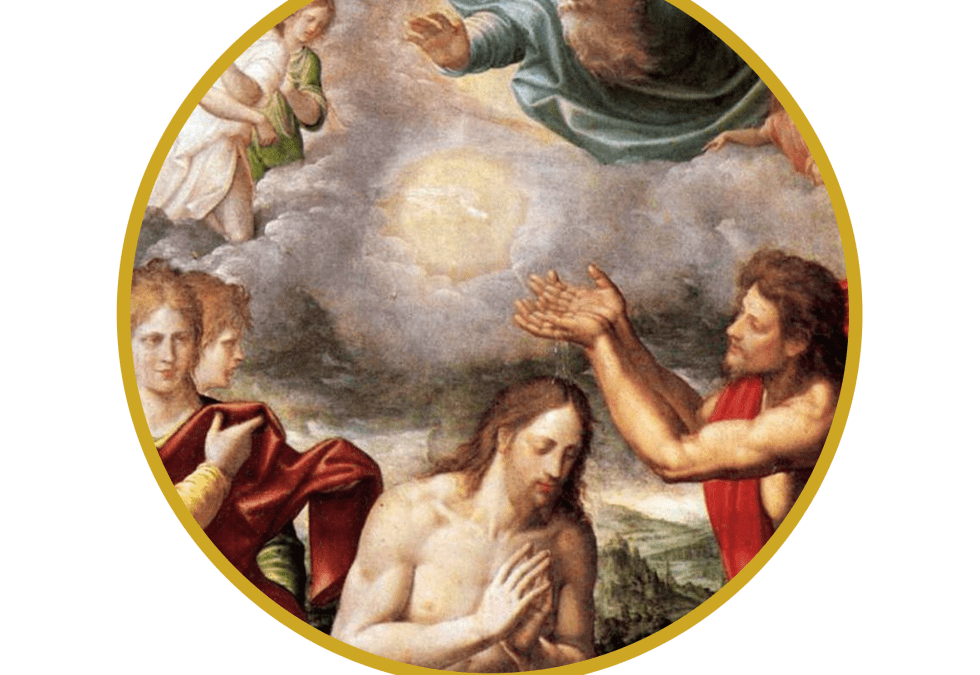
by popadmin | Jan 9, 2022 | CIC Saint Writeups
8 January: Feast of the Baptism of the Lord. Today, we celebrate the baptism of Christ in the Jordan by John the Baptist: a milestone event in the life of Jesus and in Christianity. This feast day is usually celebrated on the Sunday after the Feast of the Epiphany. It brings to an end the liturgical season of Christmas. {Christmas is the feast of God’s self-revelation to the Jews, and Epiphany celebrates God’s self-revelation to the Gentiles.} At his Baptism, Christ reveals himself again, this time to repentant sinners. The Baptism of Jesus also marks the first public revelation of all Three Persons in the Holy Trinity, and the official revelation of Jesus as the Son of God to the world by God the Father. Jesus’s baptism is described in all four Gospels and it marks the beginning of his public ministry. “After Jesus was baptized, he came from the water and behold, the heavens were opened [for him], and he saw the Spirit of God descending like a dove [and] coming upon him. And a voice came from the heavens, saying, ‘This is my beloved son, with whom I am well pleased’ ” (Mt 3:16-17). We know that Jesus, holy and sinless, did not need to be baptized. Yet he humbled himself and submitted to his Father’s will. Jesus’s baptism sanctified the waters and instituted the Sacrament of Baptism. The Catechism of the Catholic Church states: Our Lord voluntarily submitted himself to the baptism of St. John, intended for sinners, in order to “fulfill all righteousness.” Jesus’ gesture is a manifestation of his self-emptying. The Spirit who had hovered over the waters of the first creation descended then on the Christ as a prelude of the new creation, and the Father revealed Jesus as his “beloved Son.” (CCC 1224) Fr. Antony Kadavil explains this further: “Neither John nor Jesus invented baptism. It had been practiced for centuries among the Jews as a ritual equivalent to our Confession. Until the fall of the Temple in 70 A.D., it was common for Jewish people to use a special pool called a Mikveh – literally a “collection of water” – as a means of spiritual cleansing. Men took this bath weekly on the eve of the Sabbath; women, monthly. Converts were also expected to take this bath before entering Judaism. The Orthodox Jews still retain the rite. John preached that such a bath was a necessary preparation for the cataclysm that would be wrought by the coming Messiah. Jesus transformed this continuing ritual into the one single, definitive act by which we begin our life of Faith. In effect, He fused His Divine Essence with the water and the ceremony. In this humble submission, we see a foreshadowing of the “baptism” of his bloody death upon the cross. Jesus’ baptism by John was the acceptance and the beginning of his mission as God’s suffering Servant. He allowed himself to be numbered among sinners. Jesus submitted himself entirely to his Father’s will. Out of love, He consented to His baptism of death for the remission of our sins.” On this glorious feast day, we also celebrate our own baptisms, which freed us from sin and made us sons and daughters of God. Through baptism, God has opened the doors to Heaven. Deo gratias!
Ideas for celebrating in your home:
- The Christian symbol for Baptism is the shell, which you can easily turn into a dinner theme. Make pasta shells, Nacho Stuffed Shells, or Italian stuffed shells. Decorate the table with sea shells (children can color or craft some if you don’t have any real ones).
- Pull out your family’s Baptismal candles and light them at dinner. Tell children about the Baptism of Our Lord and their own special Baptismal days! (Share stories from family baptisms around the dinner table: Talk about who was there, how godparents were chosen, celebration afterwards, etc.)
- This is a wonderful day to renew our baptismal vows: click here for instructions.
- Start a family tradition of celebrating baptism anniversaries: Here are ideas!
- Finally, if you have access to a pool, pond, river or stream: we dare you to take a winter plunge in celebration of Jesus’s baptism in the Jordan!
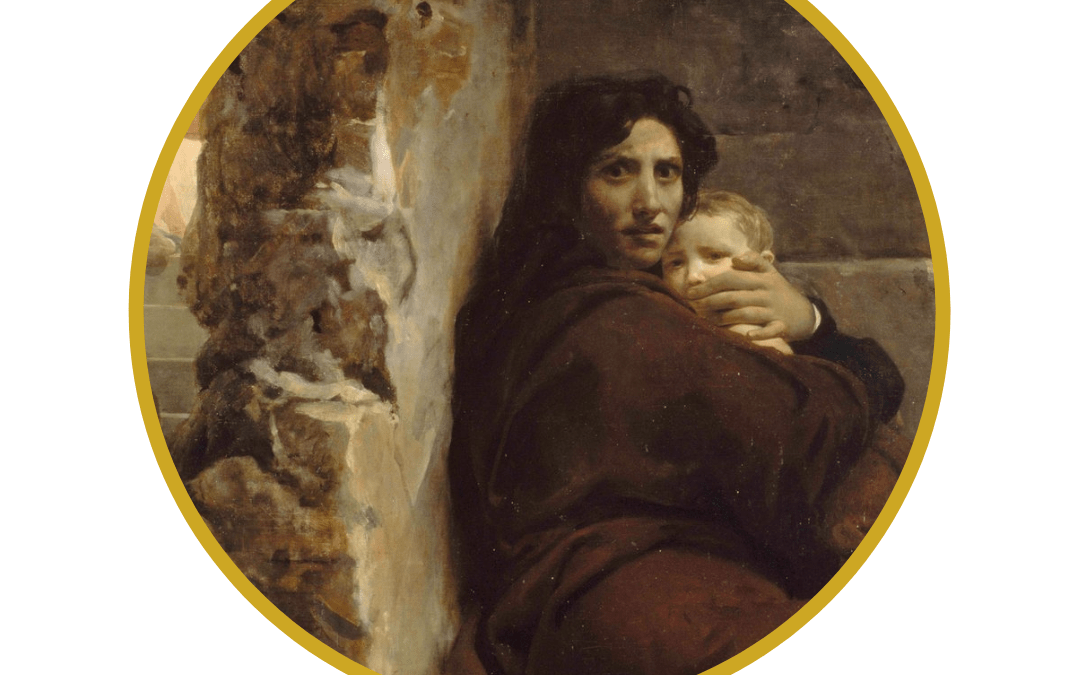
by popadmin | Dec 22, 2021 | CIC Saint Writeups
26 December: Feast of the Holy Family. Little is known about the life of Jesus’s earthly family. The gospels tell of the early years: the birth of Jesus in Bethlehem, the flight into Egypt, the finding of Jesus in the temple. Pope Leo XIII promoted this feast day as a way to counter the breakdown of the family unit. The purpose was to present the Holy Family as the model for all Christian families, and for domestic life in general. Family life becomes sanctified when we live the life of the Church within our homes. This is called the “domestic church” or the “church in miniature.” St. John Chrysostom urged Christians to make each home a “family church,” thus sanctifying the family unit. A good way to do this is by making Christ the center of family life: read scripture regularly, pray together as a family, attend Mass, go to confession, teach children about virtues, learn about and imitate the lives of the saints, live liturgically (follow the church calendar at home), and so forth. It is important to note that we don’t become holy despite the busyness of family life, but in and through it. On this feast, may the virtuous example of the Holy Family of Nazareth inspire us to develop homes full of prayer, love, and holiness.
28 December: Feast of the Holy Innocents (‘Childermas’). On the fourth day in the octave of Christmas, the Church remembers the massacre of innocent children in Bethlehem as told in Matthew 2:16-18. King Herod had ordered the death of all male children aged two and under, in his attempt to kill the infant Jesus. “A voice is heard in Ramah, weeping and great mourning, Rachel weeping for her children and refusing to be comforted, because they are no more.” These children are considered martyrs, Saints of God, by the Church. This feast day is often seen as a day of merrymaking for children. It is custom to give the youngest child in the household the power to rule the day. From what to eat, where to go and what to do, the youngest is in charge. In Mexico, it is a day for children to play practical jokes and pranks on their elders. The Holy Innocents are special patrons of babies and small children. This feast is an excellent time for parents to inaugurate the custom of blessing children. Sign a cross on your child’s forehead with the right thumb and say: “May God bless you and may He be the Guardian of your heart and mind, in the name of the Father, and of the Son, and of the Holy Spirit. Amen.”
Ideas for celebrating at home:
- Plan a family dinner, having all members involved. Each person can cook or choose a favorite dish (depending on age). Make a table centerpiece by surrounding aChrist-Candle with smaller white candles representing the Holy Innocents. The number of small candles might be as many as there are children in the family. Each child is allowed to light their small candle from the flame of the Christ-Candle, signifying that just as he received life from Christ, he will live for (and if need be, die for) Christ.
- Do a fun family activity: a game, movie night, reading books aloud together, bonfire, or outing (hike, walk, bike ride). Make popcorn balls, a fun kitchen activity to get all hands involved from young to old.
- Pray together: the rosary, especially the Joyful mysteries, is an excellent family prayer.
- Prayer of Consecration of the Family to the Holy Family, the Prayer of Parents for Their Childrenand Prayer to the Holy Family can all be said on this feast day.
- Purchase a holy family statue or icon for your home, if you don’t own one already.
- Read Pope Leo XIII’s encyclical On Christian Marriage. You can also check out the Vatican’s page of Papal documents on the Family.
- Go to mass! 26 December is a Sunday and follows the regular mass schedule. On Tuesday, 28 December, there will be a 9am mass that includes a special Blessing of Children at Prince of Peace. Be sure and bring your children to POP for their blessing!
“The first witnesses of Christ’s birth, the shepherds, found themselves not only before the Infant Jesus but also a small family: mother, father and newborn son. God had chosen to reveal himself by being born into a human family and the human family thus became an icon of God! …Indeed, the family is the best school at which to learn to live out those values which give dignity to the person and greatness to peoples. …The Holy Family of Nazareth is truly the “prototype” of every Christian family which, united in the Sacrament of Marriage and nourished by the Word and the Eucharist, is called to carry out the wonderful vocation and mission of being the living cell not only of society but also of the Church, a sign and instrument of unity for the entire human race. …May [the holy family] help Christian families to be, in every part of the world, living images of God’s love.” – Pope Benedict XVI

by popadmin | Dec 14, 2021 | CIC Saint Writeups
An ancient Christian tradition is to pray the O Antiphons during the Octave before Christmas. Sometimes called the Greater Antiphons, or the O’s of Advent, these seven responses are sung or recited before and after the Canticle of Mary (the Magnificat) at evening prayer of the Divine Office (and before the Gospel at mass) from 17 December to 23 December. Each Antiphon highlights a name or title for the Messiah, and each one refers to a prophecy of Isaiah of the coming Messiah:
- O Sapientia (O Wisdom): Isaiah 11:2–3; 28:29
- O Adonai (O Lord): Isaiah 11:4–5; 33:22
- O Radix Jesse (O Root of Jesse): Isaiah 1:1; 11:10
- O Clavis David (O Key of David): Isaiah 9:6; 22:22
- O Oriens (O Rising Sun): Isaiah 9:1
- O Rex Gentium (O King of the Nations): Isaiah 9:5; 2:4
- O Emmanuel (God with us): Isaiah 7:14
Originally written in Latin, the Church has been singing the O Antiphons since at least the eighth century. They are a magnificent theology that uses ancient Biblical imagery drawn from the messianic hopes of the Old Testament to proclaim the coming Christ as the fulfillment not only of Old Testament hopes, but present ones as well. Their repeated use of the imperative “Come!” embodies the longing of all for the Divine Messiah. Each antiphon is addressed to God using a noble title, petitioning Him to come save His people. Each antiphon is also tied to Mary because she is the vessel through which the Savior will be born. The order of the antiphons climbs climatically through the history of Redemption: In the first, O Sapientia, we take a backward flight into the recesses of eternity to address Wisdom, the Word of God. In the second, O Adonai, we have leaped from eternity to the time of Moses and the Law of Moses (about 1400 B.C.). In the third, O Radix Jesse, we have come to the time when God was preparing the line of David (about 1100 B.C.). In the fourth, O Clavis David, we have come to the year 1000. In the fifth, O Oriens we see that the line of David is elevated so that the peoples may look on a rising star in the east, and hence in the sixth, O Rex Gentium, we know that He is king of all the world of man. This brings us to the evening before the vigil, and before coming to the town of Bethlehem, we salute Him with the last Great O, O Emmanuel: God with us. It is widely pointed out that if you take the first letter of each Latin name and reverse the order – Emmanuel, Rex, Oriens, Clavis, Radix, Adonai, Sapientia – the Latin words ERO CRAS are formed, meaning, Tomorrow, I will come. Therefore, the Lord Jesus, whose coming we have prepared for in Advent and whom we have addressed in these seven Messianic titles, now speaks to us, Tomorrow, I will come. The O Antiphons not only bring intensity to our Advent preparation, but bring it to a joyful conclusion. We can bring these responses into our daily prayer time during the Octave before Christmas as simple reminders of the one whose coming we are joyfully anticipating.
Sometime before the 12th century, selected verses from the antiphons were compiled into the hymn “O Come, O Come, Emmanuel.” It is believed to be among the oldest of all the Christmas hymns. Sing this hymn around your advent wreath each night of the O Antiphons as a beautiful way to draw hearts closer to Christ and to prepare for His coming at Christmas.
Visit the link below to print a beautiful O Antiphons Prayer Companion that includes all the antiphons, symbols, prayers, and food suggestions for each day of the Octave:
(Sources: familyfeastandferia.com; catholicculture.org; loyolapress.com; simplycatholic.com; usccb.org)






Recent Comments